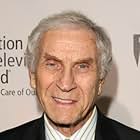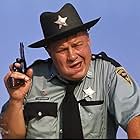IMDb RATING
6.9/10
1.4K
YOUR RATING
Students faced with an ethical dilemma about the dehumanization associated with the tradition of hazing, at a military college in the Southern United States, take matters in their own hands.Students faced with an ethical dilemma about the dehumanization associated with the tradition of hazing, at a military college in the Southern United States, take matters in their own hands.Students faced with an ethical dilemma about the dehumanization associated with the tradition of hazing, at a military college in the Southern United States, take matters in their own hands.
Peter Mark Richman
- Cadet Colonel Corger
- (as Mark Richman)
Vergel Cook
- Jo
- (uncredited)
Storyline
Did you know
- TriviaBen Gazzara, Pat Hingle, Peter Mark Richman (as Mark Richman), Arthur Storch, and Paul E. Richards played the same roles on stage. The play "End as a Man" opened on Broadway at the Vanderbilt Theatre, 148 W. 48th St. on 14 October 1953 and ran for 105 performances.
- GoofsWhen Jocko and Julie go to the Savanarola Club in town, there is a neon sign in a window with open blinds as seen from the outside. But when they step inside, the blinds in the window are closed and no light from the neon sign is seen.
- ConnectionsFeatured in Ben Gazzara Remembers the Strange One (2009)
Featured review
Originally advertised as the first picture filmed entirely by a cast and technicians from the Actor's Studio, this tale of power play amongst the cadets of a Southern military academy, only comes alive when it features the material that the Production Code of the 1950's demanded be cut.
Based on the autobiographical novel and play End as a Man by Calder Willingham, director Jack Garfein uses the music of Kenyon Hopkins noticably in the scenes between Ben Gazzara as an upperclass man and Paul E Richards as a presumably gay cadet Gazzara nicknames Cockroach, who wears a shower cap when the other cadets don't. Richards is a "creative writer" who names the Gazzara character in his novel "nightboy". Their best scene together is where Richards reads to Gazzara, who plays with his sword! Clearly Gazzara is not adverse to Richard's attention, and their farewell handshake is more a sensual than manly experience. Gazzara's relationship with Richards is also echoed in his friendship with football jock James Olson, where Gazzara reacts to being casually touched. I also like idea of Gazzara's cigarette holder, though his kissing his own wrist at one point is a little too self-consciously Method.
But whilst it is interesting to observe these subversive (for the period) elements, the narrative ultimately disappoints in the treatment of Gazzara as the academy's resident sadist. The Actors Studio adaptation needs to create an ensemble, as opposed to allowing Gazzara to star, which dissipates the tension and reduces his threat. Whilst it may be more psychologically truthful for him to underplay his psychotic nature, with the addition of Freudian insight which makes him more intellectual than physically violent, this doesn't help the drama, which is even more obvious when the far more satisfying climax uses mob intimidation and a physical act of revenge.
The worst of the Actors Studio excess is in the presentation of victim Arthur Storch who is said to be schizophrenic and thus an easy target. Storch has coke-bottle spectacles, buck teeth, cartoon at attention posture, ambition to become a priest, is a mommy's boy, afraid of women, and anti-alcoholic. Gazzara's interest in Storch is inexplicable, even if he does hold him down while Olson spanks him with a broom, but as a good part of the film has us trapped in one room (the stage origins show here) while we're supposed to observe how bad Gazzara is, proceedings crawl into tedium. Or perhaps this kind of s/m power play just doesn't hold that much interest for me. The academy rooms have cell-like iron gates in front of the doors, and even though they aren't locked, the film opens with a guard hitting each as he passes, doing a role call.
Watch for Gazzara's sci-fi buggy car, which has room in the back for a passenger.
Based on the autobiographical novel and play End as a Man by Calder Willingham, director Jack Garfein uses the music of Kenyon Hopkins noticably in the scenes between Ben Gazzara as an upperclass man and Paul E Richards as a presumably gay cadet Gazzara nicknames Cockroach, who wears a shower cap when the other cadets don't. Richards is a "creative writer" who names the Gazzara character in his novel "nightboy". Their best scene together is where Richards reads to Gazzara, who plays with his sword! Clearly Gazzara is not adverse to Richard's attention, and their farewell handshake is more a sensual than manly experience. Gazzara's relationship with Richards is also echoed in his friendship with football jock James Olson, where Gazzara reacts to being casually touched. I also like idea of Gazzara's cigarette holder, though his kissing his own wrist at one point is a little too self-consciously Method.
But whilst it is interesting to observe these subversive (for the period) elements, the narrative ultimately disappoints in the treatment of Gazzara as the academy's resident sadist. The Actors Studio adaptation needs to create an ensemble, as opposed to allowing Gazzara to star, which dissipates the tension and reduces his threat. Whilst it may be more psychologically truthful for him to underplay his psychotic nature, with the addition of Freudian insight which makes him more intellectual than physically violent, this doesn't help the drama, which is even more obvious when the far more satisfying climax uses mob intimidation and a physical act of revenge.
The worst of the Actors Studio excess is in the presentation of victim Arthur Storch who is said to be schizophrenic and thus an easy target. Storch has coke-bottle spectacles, buck teeth, cartoon at attention posture, ambition to become a priest, is a mommy's boy, afraid of women, and anti-alcoholic. Gazzara's interest in Storch is inexplicable, even if he does hold him down while Olson spanks him with a broom, but as a good part of the film has us trapped in one room (the stage origins show here) while we're supposed to observe how bad Gazzara is, proceedings crawl into tedium. Or perhaps this kind of s/m power play just doesn't hold that much interest for me. The academy rooms have cell-like iron gates in front of the doors, and even though they aren't locked, the film opens with a guard hitting each as he passes, doing a role call.
Watch for Gazzara's sci-fi buggy car, which has room in the back for a passenger.
- petershelleyau
- Mar 30, 2003
- Permalink
- How long is The Strange One?Powered by Alexa
Details
- Runtime1 hour 40 minutes
- Color
- Aspect ratio
- 1.85 : 1
Contribute to this page
Suggest an edit or add missing content
































